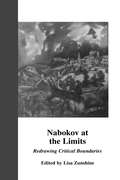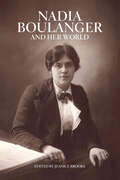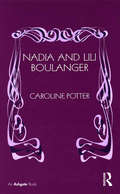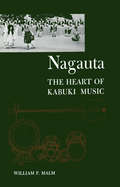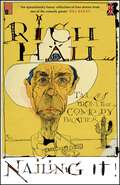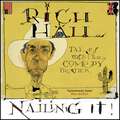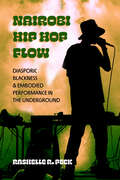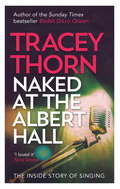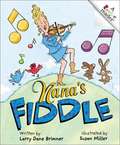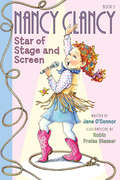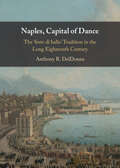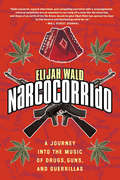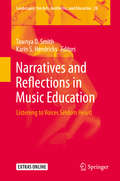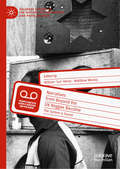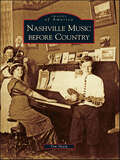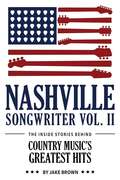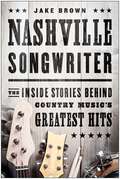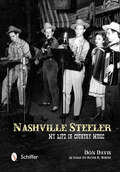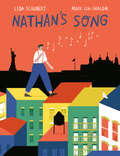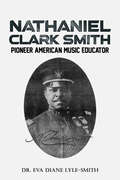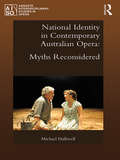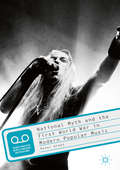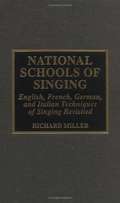- Table View
- List View
Nabokov at the Limits: Redrawing Critical Boundaries (Border Crossings)
by Lisa ZunshineThe eleven contributors to this volume investigate the connections between Nabokov's output and the fields of painting, music, and ballet.
Nadia Boulanger and Her World (Bard Music Festival)
by Jeanice BrooksNadia Boulanger (1887–1979) was arguably one of the most iconic figures in twentieth-century music, and certainly among the most prominent musicians of her time. For many composers— especially Americans from Aaron Copland to Philip Glass—studying with Boulanger in Paris or Fontainebleau was a formative moment in a creative career. Composer, performer, conductor, impresario, and charismatic and inspirational teacher, Boulanger engaged in a vast array of activities in a variety of media, from private composition lessons and lecture-recitals to radio broadcasts, recordings, and public performances. But how to define and account for Boulanger’s impact on the music world is still unclear. Nadia Boulanger and Her World takes us from a time in the late nineteenth century, when many careers in music were almost entirely closed to women, to the moment in the late twentieth century when those careers were becoming a reality. Contributors consider Boulanger’s work in the worlds of composition, musical analysis, and pedagogy and explore the geographies of transatlantic and international exchange and disruption within which her career unfolded. Ultimately, this volume takes its title as a topic for exploration—asking what worlds Boulanger belonged to, and in what sense we can consider any of them to be “hers.”
Nadia and Lili Boulanger
by Caroline PotterPioneers in their fields and two of the best-known women in music in the twentieth century, Nadia and Lili Boulanger have previously been considered in isolation from one another. Yet, as Caroline Potter's new book demonstrates, their careers were closely linked during Lili Boulanger's short life (1893-1918) and there are several intriguing connections between their musical works. This biography also provides the first full analysis of the Boulanger sisters' musical styles, placing them within the context of French musical history. Their lives are also a case study in the issues of gender which surround music making even to the present day. Despite an unusually privileged upbringing, Nadia and Lili Boulanger exemplify the struggle women experienced when attempting to enter the professional music world. Lili became the first woman to win the Prix de Rome in 1913, and Nadia gained second place in 1908. Yet in spite of this initial success, Nadia Boulanger was to give up composing in her thirties and devoted the remainder of her long life to teaching. Her pupils included several of the great composers of the century, including Aaron Copland and Elliott Carter. This book, focusing on their musical careers, is essential reading for anyone interested in French music of the twentieth century.
Nagauta: The Heart of Kabuki Music
by William P. MalmThis study of Japanese music explore Nagauta or literally "long song"--the delicate and complex music that accompanies kabuki theater--in great detail.The Kabuki theater of Japan has achieved a growing reputation as one of the world's most brilliant achievements in the field of theater. And the number of studies made on the subject in the West has been considerable. Yet, in spite of the fact that so much of the unique brilliance of the kabuki stage depends on the character of its music, the manner in which it is used, and its integral connection with the development of the dramatic impact of the plays, very little has been written on this phase of the genre.Of particular interest are the attempts to explore the various approaches to form music in the vast repertoire of this living art music. The playing techniques of the instruments are explained, and the relations of each instrument's music to the vocal line and to the overall design is shown.The analysis is accompanied by two compete transcription of nagauta in Western notation. These transcriptions are the first complete scores of nagauta ever printed. Additional musical examples, bibliography, discography, and glossary-index add value to the text.
Nailing It
by Rich Hall'An uproariously funny collection of true stories from one of the comedy greats' - BILL BAILEY'I loved this book. Absolutely adored it. I devoured it and savoured every word. A wild and wonderful love letter to comedy' - ADAM HILLS'It's rare for comedians to be as funny on paper as they are on stage, but Rich Hall nails it' - CARL HIAASENA collection of hilarious and often absurd epiphanies in the legendary comedian's life that defined him - more in a for worse than for better kind of way - and all delivered in his unique deadpan style. Growing up, Rich Hall aspired to be a writer, and after school he trained to be a journalist. But after a stint at the Knoxville News Sentinel in Tennessee, he found himself trying to impress a girl by doing a one-man show in a state university campus in Kansas, armed with a bucket, a loudhailer and some dog biscuits. It wasn't exactly a triumph, and he didn't get the girl, but he had found his true calling.Nailing It is a collection of true stories from both Hall's professional and personal life where he really had to nail it. They're not about glitz, or fame, or how he met his seventh wife at the rehab clinic and found spiritual direction. None of that happened to him.They're about accidentally melting Kraft cheese at his first Edinburgh Fringe Festival, alienating an entire convention of RV holiday-makers in Las Vegas, singing The Who's 'You Better You Bet' at a charity gig and turning his performance into a legendary rock 'n' roll disaster, and attempting to seduce Karen, which must have been successful because she is now his wife. And other such escapades.Hall doesn't always come out of them all covered in glory - far from it - but if someone propped him up at the end of the comedy bar and put a 50p coin in him, these are the tunes he would spin. And you'd be laughing all night.
Nailing It
by Rich Hall'An uproariously funny collection of true stories from one of the comedy greats' - BILL BAILEY'I loved this book. Absolutely adored it. I devoured it and savoured every word. A wild and wonderful love letter to comedy' - ADAM HILLS'It's rare for comedians to be as funny on paper as they are on stage, but Rich Hall nails it' - CARL HIAASENA collection of hilarious and often absurd epiphanies in the legendary comedian's life that defined him - more in a for worse than for better kind of way - and all delivered in his unique deadpan style. Growing up, Rich Hall aspired to be a writer, and after school he trained to be a journalist. But after a stint at the Knoxville News Sentinel in Tennessee, he found himself trying to impress a girl by doing a one-man show in a state university campus in Kansas, armed with a bucket, a loudhailer and some dog biscuits. It wasn't exactly a triumph, and he didn't get the girl, but he had found his true calling.Nailing It is a collection of true stories from both Hall's professional and personal life where he really had to nail it. They're not about glitz, or fame, or how he met his seventh wife at the rehab clinic and found spiritual direction. None of that happened to him.They're about accidentally melting Kraft cheese at his first Edinburgh Fringe Festival, alienating an entire convention of RV holiday-makers in Las Vegas, singing The Who's 'You Better You Bet' at a charity gig and turning his performance into a legendary rock 'n' roll disaster, and attempting to seduce Karen, which must have been successful because she is now his wife. And other such escapades.Hall doesn't always come out of them all covered in glory - far from it - but if someone propped him up at the end of the comedy bar and put a 50p coin in him, these are the tunes he would spin. And you'd be laughing all night.
Nailing It
by Rich Hall'An uproariously funny collection of true stories from one of the comedy greats' - BILL BAILEYA collection of hilarious and often absurd epiphanies in the legendary comedian's life that defined him - more in a for worse than for better kind of way - and all delivered in his unique deadpan style. Growing up, Rich Hall aspired to be a writer, and after school he trained to be a journalist. But after a stint at the Knoxville News Sentinel in Tennessee, he found himself trying to impress a girl by doing a one-man show in a state university campus in Kansas, armed with a bucket, a loudhailer and some dog biscuits. It wasn't exactly a triumph, and he didn't get the girl, but he had found his true calling.Nailing It is a collection of true stories from both Hall's professional and personal life where he really had to nail it. They're not about glitz, or fame, or how he met his seventh wife at the rehab clinic and found spiritual direction. None of that happened to him.They're about accidentally melting Kraft cheese at his first Edinburgh Fringe Festival, alienating an entire convention of RV holiday-makers in Las Vegas, singing The Who's 'You Better You Bet' at a charity gig and turning his performance into a legendary rock 'n' roll disaster, and attempting to seduce Karen, which must have been successful because she is now his wife. And other such escapades.Hall doesn't always come out of them all covered in glory - far from it - but if someone propped him up at the end of the comedy bar and put a 50p coin in him, these are the tunes he would spin. And you'd be laughing all night.(P) 2022 Quercus Editions Limited
Nairobi Hip Hop Flow: Diasporic Blackness and Embodied Performance in the Underground (California Series in Hip Hop Studies)
by RaShelle R. PeckA free ebook version of this title is available through Luminos, University of California Press's Open Access publishing program. Visit www.luminosoa.org to learn more.Nairobi Hip Hop Flow combines ethnographic methods, political history, and music and performance analysis to illustrate the richness of hip hop's embodied performance practices. RaShelle R. Peck examines how hip hop artists in Nairobi's underground rap culture engage with political seriousness in lyrics and sound by fostering a creative playfulness using bodily movement. This unprecedented study shows how Nairobi artists circulate diasporic blackness while at the same time indigenizing hip hop music to interrogate Kenya’s sociopolitical landscape.
Naked at the Albert Hall: The Inside Story of Singing
by Tracey ThornIn her bestselling autobiography Bedsit Disco Queen, Tracey Thorn recalled the highs and lows of a thirty-year career in pop music. But with the touring, recording and extraordinary anecdotes, there wasn't time for an in-depth look at what she actually did for all those years: sing. She sang with warmth and emotional honesty, sometimes while battling acute stage-fright. Part memoir, part wide-ranging exploration of the art, mechanics and spellbinding power of singing, Naked at the Albert Hall takes in Dusty Springfield, Dennis Potter and George Eliot; Auto-tune, the microphone and stage presence; The Streets and The X Factor. Including interviews with fellow artists such as Alison Moyet, Romy Madley-Croft and Green Gartside of Scritti Politti, and portraits of singers in fiction as well as Tracey's real-life experiences, it offers a unique, witty and sharply observed insider's perspective on the exhilarating joy and occasional heartache of singing.
Naked at the Albert Hall: The Inside Story of Singing
by Tracey ThornIn her bestselling autobiography Bedsit Disco Queen, Tracey Thorn recalled the highs and lows of a thirty-year career in pop music. But with the touring, recording and extraordinary anecdotes, there wasn't time for an in-depth look at what she actually did for all those years: sing. She sang with warmth and emotional honesty, sometimes while battling acute stage-fright.Part memoir, part wide-ranging exploration of the art, mechanics and spellbinding power of singing, NAKED AT THE ALBERT HALL takes in Dusty Springfield, Dennis Potter and George Eliot; Auto-tune, the microphone and stage presence; The Streets and The X Factor. Including interviews with fellow artists such as Alison Moyet, Romy Madley-Croft and Green Gartside of Scritti Politti, and portraits of singers in fiction as well as Tracey's real-life experiences, it offers a unique, witty and sharply observed insider's perspective on the exhilarating joy and occasional heartache of singing.
Nana's Fiddle
by Larry Dane BrimnerAlthough her neighbors are reluctant to listen to her play the fiddle, Nana persists and her hog steals the show.
Nancy Clancy, Star of Stage and Screen (I Can Read! #5)
by Jane O'Connor Robin Preiss GlasserNancy Clancy is ready for her close-up in the fifth chapter book in the Nancy Clancy chapter book series by the New York Times bestselling team of Jane O'Connor and Robin Preiss Glasser.It's <P><P>Nancy's time to shine as she takes center stage in the school play! There's no way Nancy will get stuck in the chorus again this year--she's been practicing guitar for months and her audition was superb. So when Nancy gets a callback, she's overwhelmed with joy! <P>But after Nancy's performance during the play is captured on a video that gets posted on YouTube, it seems her stardom has gone viral. Will Nancy's humiliation get the best of her, or will she find a way to embrace her newfound fame? <P>Fans of Nancy Clancy will enjoy watching Nancy sparkle in the spotlight in her latest chapter book. The central theme of all the Nancy Clancy books shines through, showing the power of positive thinking.
Naples, Capital of Dance: The ‘feste di ballo' Tradition in the Long Eighteenth Century
by Anthony R. DelDonnaRenowned as a city of entertainment, Naples was unequaled in eighteenth-century Italy for the diversity of its musical life. During the reigns of Carlo di Borbone and his heir Ferdinando IV, the sponsorship of feste di ballo, elaborate celebratory balls featuring social dance such as the minuet and contradance, grew increasingly lavish. Organized for carnevale, occasions of state, and personal celebrations in the lives of the royal family, the feste di ballo fostered both a public agenda and a personal rapport between the monarchs and local aristocracy. As the century progressed, the frequency of and resources accorded to the feste di ballo and its showcasing of social dance came to match those of stage drama and instrumental music. Based on extensive archival research, this book reveals the culture of social dance at the Bourbon court and how these spectacular events served to project images of authority, power, and identity.
Narcocorrido
by Elijah WaldIn the first full-length exploration of the contemporary and controversial Mexican corrido, award-winning author Elijah Wald blends a travel narrative with his search for the roots of this genre -- a modern outlaw music that fuses the sensibilities of medieval ballads with the edgy grit of gangsta rap. From international superstars to rural singers documenting their local current events in the regions dominated by guerilla war, Wald visited these songwriters in their homes, exploring the heartland of the Mexican drug traffic and traveling to urban centers such as Los Angeles and Mexico City. The corrido genre is famous for its hard-bitten songs of drug traffickers and gunfights, and also functions as a sort of musical newspaper, singing of government corruption, the lives of immigrants in the United States, and the battles of the Zapatista rebellion in Chiapas. Though largely unknown to English speakers, corridos top the Latin charts and dominate radio playlists both in the United States and points south. Wald provides in-depth looks at the songwriters who have transformed groups like the popular Tigres del Norte into enduring superstars, as well as the younger artists who are carrying the corrido into the twenty-first century. In searching for the poetry and social protest behind the gaudy lyrics of powerful drug lords, Wald shows how popular music can remain the voice of a people, even in this modern world of globalization, electronic media, and gangsters who ship cocaine in 747s.
Narratives and Reflections in Music Education: Listening to Voices Seldom Heard (Landscapes: the Arts, Aesthetics, and Education #28)
by Tawnya D. Smith Karin S. HendricksThis volume offers chapters written by some of the most respected narrative and qualitative inquiry writers in the field of music education. The authorship and scope are international, and the chapters advance the philosophical, theoretical, and methodological bases of narrative inquiry in music education and the arts. The book contains two sections, each with a specific aim. The first is to continue and expand upon dialogue regarding narrative inquiry in music education, emphasizing how narrative involves the art of listening to and hearing others whose voices are often unheard. The chapters invite music teachers and scholars to experience and confront music education stories from multiple perspectives and worldviews, inviting an international readership to engage in critical dialogue with and about marginalized voices in music. The second section focuses on ways in which narrative might be represented beyond the printed page, such as with music, film, photography, and performative pieces. This section includes philosophical discussions about arts-based and aesthetic inquiry, as well as examples of such work.
Narratives from Beyond the UK Reggae Bassline: The System is Sound (Palgrave Studies in the History of Subcultures and Popular Music)
by Matthew Worley William ‘Lez’ HenryThis book explores the history of reggae in modern Britain from the time it emerged as a cultural force in the 1970s. As basslines from Jamaica reverberated across the Atlantic, so they were received and transmitted by the UK’s Afro-Caribbean community. From roots to lovers’ rock, from deejays harnessing the dancehall crowd to dub poets reporting back from the socio-economic front line, British reggae soundtracked the inner-city experience of black youth. In time, reggae’s influence permeated the wider culture, informing the sounds and the language of popular music whilst also retaining a connection to the street-level sound systems, clubs and centres that provided space to create, protest and innovate. This book is therefore a testament to struggle and ingenuity, a collection of essays tracing reggae’s importance to both the culture and the politics of late twentieth and early twenty-first century Britain.
Nashville Music before Country (Images of America)
by Tim SharpNashville is a name synonymous with music. Years before the first radio broadcast of country music from Nashville�s Grand Ole Opry, music and publishing were central to Nashville�s self-identity. Thousands of songs flooded into the Cumberland and Tennessee River valleys from Southern Appalachia, sung by folk performers. These songs became the foundation for the folk-hymn traditions that grew throughout Tennessee. Into this stream flowed a body of African American spirituals, gospel, and minstrel songs. The arrival of trained German musicians brought classical styles to this gathering stream of musical confluences. These musicians found a home in the academies and businesses of Nashville. Nashville Music before Country is the story of how music merged with education, publication, entertainment, and distribution to set the stage for a unique musical metropolis. The images for Nashville Music before Country come from private collections as well as public libraries and archives.
Nashville Songwriter, Volume 2: The Inside Stories Behind Country Music's Greatest Hits
by Jake BrownNashville's best-kept secret has long been that the majority of country music's biggest hits are written by a Shakespearean behind-the-scenes club of Music Row songsmiths who have churned out many of country's most beloved classics over the past fifty years. Picking up with Volume II of the first-of-its-kind “NASHVILLE SONGWRITER” book series, country music fans get more behind-the-scenes V.I.P. access as this book series reveals the first TOTALLY AUTHORIZED telling of the true stories that inspired hundreds of # 1s by a collective roster of the biggest multi-platinum Country Superstars. <P><P> With 300+ # 1 hits covered throughout the 300+ page book, including many of today's hottest Country Music hits, including recent Carrie Underwood, Lady Antebellum, George Strait, Florida/Georgia Line, Sam Hunt, Eric Church, Miranda Lambert, Tim McGraw, Little Big Town, Jason Aldean, Dierks Bentley, Thomas Rhett, Thomas Rhett, Kenny Chesney, Miranda Lambert, Blake Shelton, George Jones, Zac Brown Band, Toby Keith, Cole Swindell, Johnny Lee, Loretta Lynn, Jerry Reed, Vince Gill, Conway Twitty, Merle Haggard, the Dixie Chicks, Rodney Atkins, Rhett Akins, Luke Bryan, Dustin Lynch, Alan Jackson, Lee Anne Womack, Martina McBride, Gary Evans, etc.
Nashville Songwriter: The Inside Stories Behind Country Music's Greatest Hits
by Jake BrownYou've heard them on the radio, listened to them on repeat for days, and sang along at the top of your lungs—but have you ever wondered about the real stories behind all your favorite country songs? Nashville Songwriter gives readers the first completely authorized collection of the true stories that inspired hits by the biggest multi-platinum country superstars of the last half century—recounted by the songwriters themselves. Award-winning music biographer Jake Brown gives readers an unprecedented, intimate glimpse inside the world of country music songwriting. Featuring exclusive commentary from country superstars and chapter-length interviews with today's biggest hit-writers on Music Row, this book chronicles the stories behind smash hits such as: Willie Nelson's "Always on My Mind" Tim McGraw's "Live Like You Were Dying," "Southern Voice," and "Real Good Man" George Jones's "Tennessee Whiskey" Carrie Underwood's "Jesus Take the Wheel" and "Cowboy Casanova" Brooks & Dunn's "Ain't Nothing 'Bout You" Lady Antebellum's "We Owned the Night" and "Just a Kiss" Brad Paisley's "Mud on the Tires," "We Danced," and "I'm Still a Guy" Luke Bryan's "Play It Again," "Crash My Party," and "That's My Kind of Night" The Oak Ridge Boys's "American Made" George Strait's "Ocean Front Property" and "The Best Day," Rascal Flatts's "Fast Cars and Freedom," and "Take Me There" Kenny Chesney's "Living in Fast Forward" and "When the Sun Goes Down" Ricochet's "Daddy's Money" Montgomery Gentry's "If You Ever Stop Loving Me" The Crickets's "I Fought the Law" Tom T. Hall's "A Week in a County Jail" and "That Song Is Driving Me Crazy" Trace Adkins's "You're Gonna Miss This" David Lee Murphy's "Dust on the Bottle" Jason Aldean's "Big Green Tractor" and "Fly Over States" And many more top country hits over the past 40 years!
Nashville Steeler: My Life in Country Music
by Don Davis50-year account of the rise of country music through the career of Don DavisStories and 100 images showing legends, singers, songwriters, personalities, and fansOver 50 artists, musicians, producers, managers, and others
Nathan's Song
by Leda SchubertThe Jewish immigrant experience in the early 1900s is touchingly and joyfully portrayed in this picture book based on the author's own grandfather.Growing up in a shtetl in Russia, Nathan is always singing, and when he hears a famous opera soloist perform in a nearby town one day, he realizes that music could be his future. But he'll need to travel far from his loved ones and poor village in order to pursue that cherished goal. With his family's support he eventually journeys all the way to New York City, where hard work and much excitement await him. His dream is coming true, but how can he be fully happy when his family is all the way across the ocean?
Nathaniel Clark Smith: Pioneer American Music Educator
by Dr Eva Diane Lyle-SmithIf you are interested in learning about a pioneer African American music educator in the United States, then you want to read the story of Nathaniel Clark Smith. Smith was a prolific and charismatic music educator, musician, and composer who lived during the early years of music education history in the United States. His formal training in music was on a military base in Ft. Leavenworth, KS. Extended studies were from Guild Hall in London, England. A college graduate with B.M.A. and M.M degrees, Smith taught music in educational institutions and industries; was a world traveller who performed with the Ernest Hogan Minstrel Troupe; introduced the saxophone to African Americans; composed and published spirituals, marches, operatic songs, a suite, and an unfinished symphony; and hosted a radio broadcast show which was aired all over the Mid-West. He organized bands and out of that, orchestras, choirs, glee clubs and numerous combinations of the voice and instruments were developed. Smith captured the melodies of the countries that he visited in his music compositions.During his illustrious career, Smith worked with Frederick Douglas, Paul Lawrence Dunbar, Booker T. Washington, Nat King Cole, Lionel Hampton, Milton Hinton, John Phillip Sousa, a young Charlie Parker, and others. His students from the Lincoln High School Band became the nucleus of the big band format of the Mid-West. His Pullman Porter musicians were able to perform at a moment&’s notice.Married with one daughter and the son of an African Sergeant Trumpeter and Indian mother, The Story of Nathaniel Clark Smith is a colourful reading of the times during abolition to the mid depression years in the United States. It is the story of an African-American who survived the challenges of the time to obtain a successful music career, and who helped people to better their lives through music in the Mid-Western and Southern African-American communities of the United States.
National Identity in Contemporary Australian Opera: Myths Reconsidered (Ashgate Interdisciplinary Studies in Opera)
by Michael HalliwellOpera has been performed in Australia for more than two hundred years, yet none of the operas written before the Second World War have become part of the repertoire. It is only in the late 1970s and early 1980s that there is evidence of the successful systematic production of indigenous opera. The premiere of Voss by Richard Meale and David Malouf in 1986 was a watershed in the staging and reception of new opera, and there has been a diverse series of new works staged in the last thirty years, not only by the national company, but also by thriving regional institutions. The emergence of a thriving operatic tradition in contemporary Australia is inextricably enmeshed in Australian cultural consciousness and issues of national identity. In this study of eighteen representative contemporary operas, Michael Halliwell elucidates the ways in which the operas reflect and engage with the issues facing contemporary Australians. Stylistically these eighteen operas vary greatly. The musical idiom is diverse, ranging from works in a modernist idiom such as The Ghost Wife, Whitsunday, Fly Away Peter, Black River and Bride of Fortune, to Voss, Batavia, Bliss, Lindy, Midnight Son, The Riders, The Summer of the Seventeenth Doll and The Children’s Bach being works which straddle several musical styles. A number of operas draw strongly on musical theatre including The Eighth Wonder, Pecan Summer, The Rabbits and Cloudstreet, and Love in the Age of Therapy is couched in a predominantly jazz idiom. While some of them are overtly political, all, at least tangentially, deal with recent cultural politics in Australia and offer sharply differing perspectives.
National Myth and the First World War in Modern Popular Music
by Peter GrantThis book looks at the role of popular music in constructing the myth of the First World War. Since the late 1950s over 1,500 popular songs from more than forty countries have been recorded that draw inspiration from the War. National Myth and the First World War in Modern Popular Music takes an inter-disciplinary approach that locates popular music within the framework of 'memory studies' and analyses how songwriters are influenced by their country's 'national myths'. How does popular music help form memory and remembrance of such an event? Why do some songwriters stick rigidly to culturally dominant forms of memory whereas others seek an oppositional or transnational perspective? The huge range of musical examples include the great chansonniers Jacques Brel and Georges Brassens; folk maestros including Al Stewart and Eric Bog≤ the socially aware rock of The Kinks and Pink Floyd; metal legends Iron Maiden and Bolt Thrower and female iconoclasts Diamanda Gal#65533;s and PJ Harvey.
National Schools of Singing: English, French, German and Italian Techniques of Singing Revisited
by Richard MillerA comprehensive update of a 1977 study of historical and current techniques practiced in four major Western European schools of vocalism, investigating which techniques within the national schools are common to them all and which idiosyncratic regional tendencies remain. Contains chapters on breath management techniques, techniques of vowel formation, vibrato and national tendencies, vocal registration and national attitudes, the different types of voices, and international tonal ideals. Also discusses the North American singer and the national schools.
